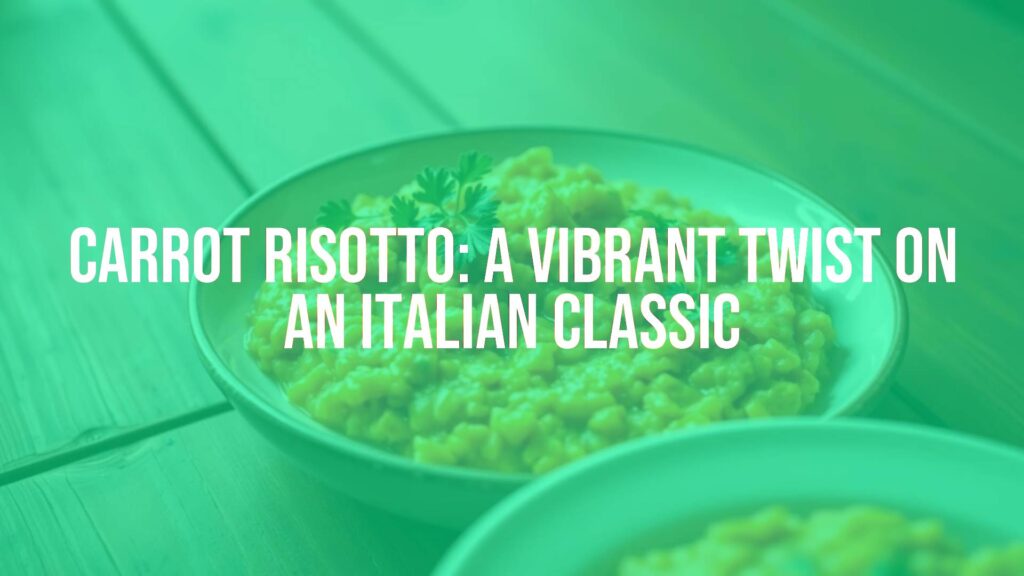Exploring the Essence of Carrot Risotto
Carrot risotto offers a refreshing spin on the traditional Italian rice dish, infusing it with the bright color and natural sweetness of carrots. This creative take on risotto not only introduces a pop of orange to the plate but also highlights the delicate balance between creamy textures and subtly earthy flavors. Known for its inviting appearance and comforting mouthfeel, carrot risotto is a testament to the versatility of Italian cuisine and the importance of high-quality, seasonal produce.
Origins and Culinary Context
While risotto originates from Northern Italy, especially the regions of Lombardy and Veneto, the addition of carrots demonstrates the Italian penchant for improvising with locally available vegetables. Carrot risotto itself is not rooted in centuries-old tradition, but rather reflects contemporary approaches to home cooking and restaurant menus, where creative flavor combinations emerge within the well-loved framework of risotto. Its popularity echoes the Italian philosophy of transforming humble ingredients into elegant, satisfying dishes.
Signature Characteristics
Carrot risotto stands out with its luminous orange hue, creamy consistency, and subtle layers of flavor. The carrots bring a gentle sweetness and a whisper of earthiness, complementing the rich, starchy rice and often enhanced by aromatic ingredients like shallots, leeks, or a touch of garlic. It is typically finished with butter and grated Parmigiano-Reggiano, which lend extra depth and silkiness. The overall effect is pleasingly smooth, with each grain of rice perfectly tender yet distinct.
Key Ingredients and Preparation
The foundation of any risotto is arborio, carnaroli, or vialone nano rice, prized for their high starch content and ability to absorb liquid while maintaining texture. In carrot risotto, carrots are grated, puréed, or finely diced, then sautéed and sometimes simmered with the rice to infuse the grains with color and flavor. The dish typically includes vegetable or light chicken stock, white wine, onions or shallots, and a finishing touch of butter and cheese. Some preparations incorporate carrot juice for an intensified carroty sweetness and a saturated color.
Regional Influences and Variations
Carrot risotto does not belong to a single Italian region, but rather reflects modern Italian cooking's embrace of vegetables in risotto. In some areas, it might be paired with herbs such as thyme or parsley, or enriched with mascarpone cheese for added creaminess. Creative chefs may integrate other root vegetables (like parsnips) or even spice the dish with ginger for a subtle warmth. Vegan adaptations replace butter and cheese with olive oil and nutritional yeast or non-dairy cheese alternatives, allowing more people to enjoy this contemporary classic.
Substitutions and Serving Tips
Carrot risotto is highly adaptable. If arborio rice is unavailable, carnaroli or vialone nano are excellent substitutes. Vegetable stock is preferred for a pure, unadulterated flavor, but a light chicken broth can also be used. To enhance presentation and flavor, consider topping the risotto with roasted carrot ribbons, microgreens, or a drizzle of herbed oil. For a nutty contrast, toasted hazelnuts or walnuts can be sprinkled over just before serving.
Pairing Suggestions
This risotto pairs beautifully with light, aromatic white wines such as Pinot Grigio, Verdicchio, or a crisp Sauvignon Blanc, which mirror the dish's freshness. For a non-alcoholic option, a lightly sparkling mineral water with a twist of lemon works well. Serve carrot risotto as an elegant first course (primo), or as a vegetarian main, perhaps accompanied by a simple salad of arugula and shaved fennel for textural contrast and palate-cleansing brightness.
Conclusion
With its appealing color and gentle flavors, carrot risotto is a wonderful showcase for the subtlety of Italian culinary traditions. By elevating a basic ingredient into a refined meal, it embodies both the creativity and simplicity that are hallmarks of Italy's cherished food culture.

